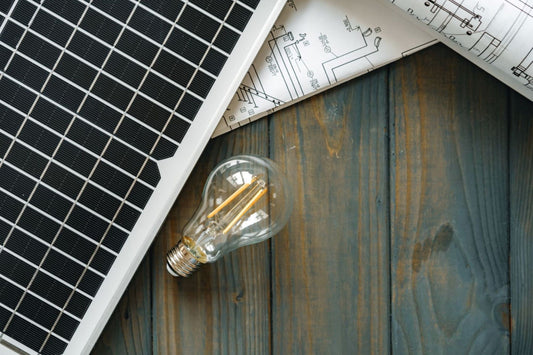
CHARGING SOLAR PANELS WITH A LIGHT BULB OR LED: CAN IT BE DONE?
As the world increasingly embraces renewable energy sources, solar panels stand out as a leading technology for sustainable electricity generation. By capturing sunlight and converting it into electrical power, these panels provide a green alternative to fossil fuels. However, what if the sun isn't shining brightly one day or it's cloudy: Can solar panels be charged using artificial lighting? Well, there’s not a straight answer so let’s talk more about it.
MECHANICS OF A SOLAR PANEL
Light can either be absorbed, reflected, or passed through a photovoltaic (PV) cell. Photovoltaic cells (PV cells) are composed of semiconductor materials that can absorb light and convert it into electrical energy by moving electrons. The conductive metal contacts on the cell collect this current and use it to produce electricity. The amount and wavelength of light affect how efficient a solar cell is. There is a direct correlation between the length of a wavelength and its energy content. The semiconductor's "band gap" determines which wavelengths the cell can absorb and convert to electricity, meaning only light within a specific range is utilized efficiently. To improve efficiency, multi-layer solar cells have been developed. These cells layer silicon with impurities, each layer responding to different wavelengths. The top layer absorbs shorter wavelengths, and the bottom layer converts longer ones, significantly enhancing conversion efficiency and energy output.
Types of Artificial Lighting and Their Potential for Charging Solar Panels
Not all artificial lights are created equal, and their effectiveness in charging solar panels varies considerably. Let's examine the most common types of artificial lighting and evaluate their potential to serve as substitutes for natural sunlight.
- LED Lights: Known for their energy efficiency, LEDs can be designed to emit specific wavelengths of light. They are widely used in indoor environments and can mimic certain aspects of natural light. However, the overall intensity of LEDs is much lower than that of sunlight, which limits their effectiveness in charging solar panels. While they might provide some energy, it is usually insufficient for significant power generation.
- Fluorescent Lights: These lights emit a relatively broad spectrum of light, making them more efficient than incandescent bulbs. However, their intensity is still considerably lower than that of natural sunlight. As a result, fluorescent lights can only partially charge solar panels, and the energy produced is typically minimal.
- Incandescent Bulbs: Traditional incandescent bulbs emit light across a broad spectrum but are notoriously inefficient. They convert most of their energy into heat rather than light, making them an impractical choice for charging solar panels. Their low intensity further diminishes their utility in this context.
CAN SOLAR PANELS BE CHARGED USING ARTIFICIAL LIGHT?
While it is technically possible to charge solar panels with artificial lighting, the process is highly inefficient and impractical for most applications. The low intensity and limited spectrum of artificial lights mean that the energy generated will be minimal.
Solar panels are designed to harness the abundant energy provided by the sun, making them most efficient in direct sunlight. Artificial lighting can serve as a temporary or supplementary measure in specific situations, but it cannot replace the efficiency and effectiveness of natural sunlight for charging solar panels.
CONCLUSION
At Forthlighting, we strive to blend beauty and sustainability seamlessly. Our solar lights are designed for both outdoor and indoor use, enhancing spaces from gardens and patios to living rooms with our solar flood lights. We believe that you shouldn't have to choose between stylish lighting and eco-friendly solutions, so our products offer the best of both worlds.